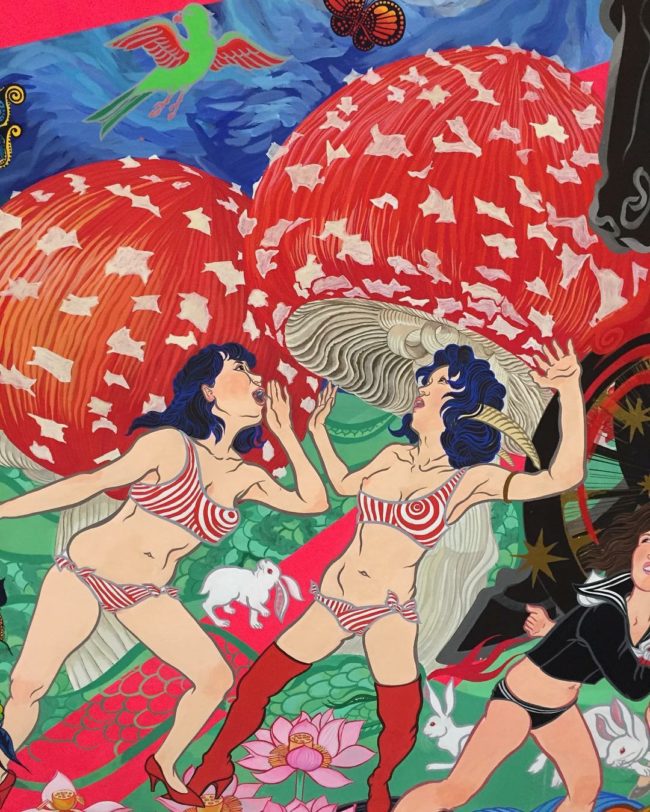2016—The Year of the Woman

*Complete version of my portion for a list of favourite exhibitions in 2016 on Tokyo Art Beat.
For me, 2016 was the Year of the Woman Artist. These were the artists whose events I most greatly anticipated or talked about. Their art could be seen at small or large galleries and also at alternative spaces. Their careers cover the nineteenth, twentieth, and twenty-first centuries and several countries.
Even before the year began, I was telling people that the must-see shows of 2016 were Mary Cassatt at the Yokohama Art Museum and Julia Margaret Cameron at the Mitsubishi Ichigokan Museum at Marunouchi. They both exemplified the New Woman of the 19th century, used friends and family as models, were known for their portraits of women and children, and experimented with innovative and unconventional techniques. Both were regarded as risky shows for the museums because they each featured a woman artist and many works on paper. The intaglio prints by Mary Cassatt and Edgar Degas were the hidden jewels of the Yokohama show, but Cameron’s photographs were especially daring since some critics still do not regard photography as a legitimate art form. Cassatt was one of the few women and perhaps the only American in the Impressionists; Cameron found acceptance of her portraits amongst the Pre-Raphaelites. Cassatt’s interest in Japanese art, especially ukiyo-e prints, influenced her compositions, and the multi-coloured aquatint prints echoed mokuhanga woodblock prints and were her contribution to the graphic arts. Cameron treated photography as more than just science but also as art form. The curators wisely had a photo booth where people could use their own cameras to take portraits of themselves in Cameron’s distinctive soft-focus style but in colour rather than sepia. Both shows featured work that I had never expected to see in real life outside of a book.
As for artists in the twenty-first century, Nanami Ishihara, Tanya Tanaka, Cindy Mochizuki, and Karin Pisarikova continued that spirit of adventure and crossed national borders.
Ishihara’s paintings at the Artcomplex Center of Tokyo (ACT) amazed all viewers. She played with images of women common to the Japanese iconography such as pearl divers and schoolgirls in uniform and used humor to make powerful but subtle feminist statements where the women were in control and not simply the sexualized subject of the male gaze. After a trip the United States, what will she make in 2017? Tanya Tanaka‘s exhibition reflected the international trend of artists showing outside traditional galleries by being displayed in Le Petit Bedon , a French restaurant in Daikanyama. Tanaka’s pastel-coloured, geometric digital drawings were a departure from her photography featured at past Pechakucha events.

Cindy Mochizuki‘s show and artist talk at the Wakayama Gallery in Ginza provided a lot of food for thought. She was Japanese-Canadian, and some of her family had been deported from Canada to Fukuoka, Japan during WWII and then returned to Canada afterwards. I am a Mennonite-Canadian who used to live in Fukuoka, Japan. Her installation of small ceramic flowers revolved around her telling her family’s stories, focusing on the continuation of Japanese cultural traditions over the years and across the seas. If she was born and raised in Canada but embraced Japanese culture as her own, what does that say about me and other foreign residents in Japan? Are those same traditions now ours and could they ever be ours? (The Wakayama Gallery is also interesting since it is the personal collection or archive of printed material, primarily children’s books and magazines.)
Karin Pisarikova‘s show at the Czech Centre continued her exploration of unconventional materials such as human hair collected at local salons. Photographs of statues with hairy blankets and hair pieces lined the walls, and masks made from hair hung from the ceiling.
One woman was willing to push the limits of what was acceptable even further — Megumi Igarashi (aka Rokudenashiko or 6D745) famed for her vagina kayak. Tomoko Ashikaga from the Waiting Room in Ebisu hosted a discussion as part of the First Saturday series at the Sunday Cafe. Igarashi and the curator at Ganka Garou ( aka the Opthomologist’s Gallery) discussed Igarashi’s artwork, police raids, the ongoing court case, and Igarashi’s experience in prison while she awaited trial. She had been declared not guilty of the more severe obscenity charges but was fined for digital transmission of a 3D scan of her genitalia as part of her crowdfunding efforts. Unlike other artists or businesses, she refused to pay fines or to say she was guilty.

Regardless of what you think about her art, she was a fascinating speaker, and Japan’s art world needs to support her and her fight for artistic freedom.

Women artists were everywhere last year. Another big show was the Niki de St Phalle one at the National Art Center, Tokyo. When asked, several gallery owners and curators in Tokyo agreed that Chiharu Shiota‘s installation at Yokohama’s Kanagawa Arts Theatre was one of their favourites. This was after making headlines at the Japanese pavilion as part of the Venice Biennale art exhibition. The year of 2016 proved that women artists were worthy of solo shows and could bring in the crowds.
What will amazing women artists do in 2017?




I am truly envious, especially of seeing Julie Cameron’s work which I truly love. All of the shows look great though!
<3 Renata